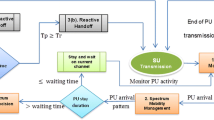Abstract
Most existing works on cognitive radio networks assume that cognitive (or secondary) users are capable of switching/jumping to any available channel, regardless of the frequency gap between the target and the current channels. Due to hardware limitations, cognitive users can actually jump only so far from where the operating frequency of their current channel is, given an acceptable switching delay that users are typically constrained by. This paper studies the performance of cognitive radio networks with dynamic multichannel access capability, but while considering realistic channel handoff assumptions, where cognitive users can only move/jump to their immediate neighboring channels.
Specifically, we consider a cognitive access network with m channels in which a cognitive user, currently using a particular channel, can only switch to one of its k immediate neighboring channels. This set of 2k channels is referred to as the target handoff channel set. We first model this cognitive access network with restricted channel handoff as a continuous-time Markov process, and then analytically derive the forced termination probability of cognitive users. Finally, we validate and analyze our derived results via simulations. Our obtained results show that the forced access termination probability of cognitive users decreases significantly as the number k increases.
Access this chapter
Tax calculation will be finalised at checkout
Purchases are for personal use only
Preview
Unable to display preview. Download preview PDF.
Similar content being viewed by others
References
Ahmad, S.H.A., Liu, M., Javidi, T., Zhao, Q., Krishnamachari, B.: Optimality of myopic sensing in multi-channel opportunistic access. IEEE Transactions on Information Theory (2009)
Chen, L., Iellamo, S., Coupechoux, M., Godlewski, P.: An auction framework for spectrum allocation with interference constraint in cognitive radio networks. In: Proceedings of IEEE INFOCOM (2010)
Feng, Z., Yang, Y.: Throughput analysis of secondary networks in dynamic spectrum access networks. In: Proceedings of IEEE INFOCOM (2010)
Gur, G., Bayhan, S., Alagoz, F.: Cognitive femtocell networks: an overlay architecture for localized dynamic spectrum access. IEEE Wireless Communications 17(4) (2010)
Hamdaoui, B.: Adaptive spectrum assessment for opportunistic access in cognitive radio networks. IEEE Transactions on Wireless Communications 8(2), 922–930 (2009)
Hamdaoui, B., Shin, K.G.: OS-MAC: An efficient MAC protocol for spectrum-agile wireless networks. IEEE Transactions on Mobile Computing (August 2008)
Harada, H.: A software defined cognitive radio prototype. In: Proc. of IEEE PIMRC (2007)
Harada, H.: A feasibility study on software defined cognitive radio equipment. In: Proc. of IEEE DySPAN (2008)
Mitola III, J.: Cognitive radio: an integrated agent architecture for software-defined radio. Dissertation, Computer Comm. System Lab, Dept. of Teleinformatics, Royal Inst. Tech., Sotckholm, Sweden (2000)
Kim, H., Shin, K.G.: Efficient discovery of spectrum oppotunities with MAC-layer sensing in cognitive radio networks. IEEE Transactions on Mobile Computing (May 2008)
Li, X., Zhao, Q.C., Guan, X., Tong, L.: Optimal cognitive access of markovian channels under tight collision constraints. IEEE Journal on Selected Areas in Communications, Special Issue on Advances in Cognitive Radio Networks and Communications (to appear, 2011)
Liu, K., Zhao, Q.: Distributed learning in cognitive radio networks: multi-armed brandit with distributed multiple players. Submitted to IEEE Int. Conf. on Acousitcs, Speech, and Signal Processing (2010)
Ma, M., Tsang, D.H.K.: Joint design of spectrum sharing and routing with channel heterogeneity in cognitive radio networks. Physical Communication 2(1-2) (2009)
Ma, Y., Kim, D.I., Wu, Z.: Optimization of OFDMA-based cellular cognitive radio networks. IEEE Transactions on Communications 58(8) (2010)
Marshall, P.F.: Dynamic spectrum access as a mechanism for transition to interference tolerant systems. In: Proceedings of IEEE DySPAN (2010)
NoroozOliaee, M., Hamdaoui, B., Tumer, K.: Efficient objective functions for coordinated learning in large-scale distributed osa systems. IEEE Transactions on Mobile Computing (to appear)
Sahin, M.E., Arslan, H.: System design for cognitive radio communications. In: Proceedings of Int’l Conference on Cognitive Radio Oriented Wireless Networks and Communications (June 2006)
Sutton, P., et al: Iris: an architecture for cognitive radio networking testbeds. IEEE Communications Magazine 48(9) (2010)
Teleghan, M.A., Hamdaoui, B.: Efficiency-revenue optimality tradeoffs in dynamic spectrum allocation. In: Proc. of IEEE GLOBECOM (2010)
Timmers, M., Pollin, S., Dejonghe, A., der Perre, L.V., Catthoor, F.: A distributed multichannel MAC protocol for multihop cognitive radio networks. IEEE Transactions on Vehicular Technology 59(1) (2010)
Unnikrishnan, J., Veeravalli, V.V.: Algorithms for dynamic spectrum access with learning for cognitive radio. IEEE Transactions on Signal Processing 58(2) (August 2010)
Xiaorong Zhu, L.S., Yum, T.S.P.: Analysis of cognitive radio spectrum access with optimal channel reservation. IEEE Communications Letters 11(4), 304–306 (2007)
Author information
Authors and Affiliations
Editor information
Editors and Affiliations
Rights and permissions
Copyright information
© 2012 Springer-Verlag Berlin Heidelberg
About this paper
Cite this paper
NoroozOliaee, M., Hamdaoui, B., Znati, T., Guizani, M. (2012). Forced Spectrum Access Termination Probability Analysis under Restricted Channel Handoff. In: Wang, X., Zheng, R., Jing, T., Xing, K. (eds) Wireless Algorithms, Systems, and Applications. WASA 2012. Lecture Notes in Computer Science, vol 7405. Springer, Berlin, Heidelberg. https://doi.org/10.1007/978-3-642-31869-6_31
Download citation
DOI: https://doi.org/10.1007/978-3-642-31869-6_31
Publisher Name: Springer, Berlin, Heidelberg
Print ISBN: 978-3-642-31868-9
Online ISBN: 978-3-642-31869-6
eBook Packages: Computer ScienceComputer Science (R0)




